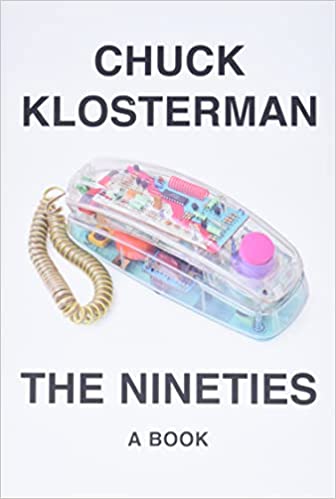You have /5 articles left.
Sign up for a free account or log in.
 The Nineties: A Book by Chuck Klosterman
The Nineties: A Book by Chuck Klosterman
Published in February 2022
My latest obsession is to think about what higher education might be like in 2050.
The framework that I’m using to think about what the university might look like 30 years in the future is to look back 30 years in the past. A reasonable hypothesis seems to be that things will change for higher education in the next three decades at least as much as things have changed over the past three.
This assumption that change averages out to be linear is likely wrong. There is a great quote in The Nineties from Vladimir Lenin: “There are decades when nothing happens, and there are weeks when decades happen.” It very well may be that the period from 1990 to 2020 saw extreme levels of higher ed change, and that the period between 2020 and 2050 will be comparatively quiet. But somehow, I doubt that will be the case.
What a 30-year-past/30-year-future framework for thinking about higher ed in 2050 does not give us are many clues about how higher education might change. If things did change a lot between 1990 and 2020, we could plausibly claim that things will also change a lot between 2020 and 2050. We just don’t know what those changes might be.
Still, there is value in adopting a historical framework to think about the future, even if that history is limited in the covered span. We need to start somewhere in thinking about the university of 2050, and 1990 is likely as good a place to start as any.
All of which is an introduction as to why it is possible to read Chuck Klosterman’s The Nineties for clues about the future of higher ed.
Do you remember higher education in the 1990s? I do—1991 was the year I finished my undergrad degree. And then I spent most of the rest of the 1990s in grad school.
In considerable measure, Klosterman’s The Nineties is about that transitional decade before and after the internet changed everything. Klosterman does not talk about how the internet changed higher education, but he could have.
In The Nineties, we get an in-depth, idiosyncratic and highly entertaining description of pre-internet media, news and communication—right at the moment before all those information industries became irrevocably different.
Klosterman devotes a long chapter to the video store. The 1990s were the heyday of store-based video rentals. At the beginning of 1990, there were just over 1,000 Blockbuster Video stores nationwide. By the start of the 2000s, there were just under 4,800 U.S. Blockbuster stores. (The number of stores would peak in the U.S. at about 5,700 in 2004.)
What killed the video store was Netflix’s DVD-by-mail experience and then streaming—neither of which is possible without the internet. Reading The Nineties is a reminder of the degree to which the culture of the video store influenced not just how movies were watched but how they were made.
The most influential filmmaker of the 1990s, Quentin Tarantino, worked at a California video store in his early 20s. (As did Kevin Smith, who set his first film, Clerks, partly in a video rental store.)
As Klosterman points out, the video store forced movie renters to select films without the benefit of a recommendation algorithm. We all spent endless hours browsing the aisles of the video store, searching for movie rentals that we might enjoy.
Pre-streaming and pre-Napster (1999), entertainment required interaction with a finite and friction-filled physical world. We had to go to the video store and the record store. Music and movies were contained on material items—the VHS tape or DVD, the record or cassette tape or CD.
The generation that came of age in the 1990s, that entered adulthood in the 1990s (my generation), will be the last one with well-developed memories and cultural fluency in pre- and post-internet society. We know what it was like when all sorts of information and entertainment was scarce and expensive, even as we fully live in a world where those same goods (music, video, news, etc.) are abundant.
Were the 1990s a pivot point for higher education, as the decade was for so many other things?
Did we start the decade off with the higher education equivalent of the landline, only to begin the next decade with whatever the university analog is to the cellphone? (The Nineties contains a terrific chapter on the cultural importance of landline phones and area codes.)
Certainly, my experiences as a college student in 1990 and 1991 were pre-internet. All classes were face-to-face. Research for papers was done in the library, utilizing paper card catalogs and physical books and journals. The microfiche machine and the photocopier played an integral role in any research project. University operations, from course catalogs to course selections, were paper-based. So were classes, with students turning in physical papers and receiving instructor feedback on the physical paper on which the assignment was delivered.
Graduate school took long enough in the 1990s that the internet changed the experience as it was happening. Academic life started in the 1990s with almost nobody sending email to closing the decade with practically all of us devoting much of our time emailing one another. Back in the 1990s, the disciplinary conversation was firmly rooted in conferences and physical journals. By the start of the next decade, that academic dialogue had become digitally mediated.
For any of us who were either college students or working at a college in the 1990s, Klosterman’s The Nineties will inspire a look back. The Nineties excels at capturing the feel of the decade. Of what it was like to live through the comparatively prosperous and straightforward times before the days of social media and hyperpartisan 24-hour news networks.
If things have changed so much about culture, work and technology between now and the 1990s, how much might things change in all these areas during the next 30 years?
If the experience of those of us who learn and work in higher education has evolved so much between 1990 and 2020, what degree of change can we expect in academic life by 2050?
What do you remember as being different about higher ed in the 1990s from how it is now?
What are you reading?








